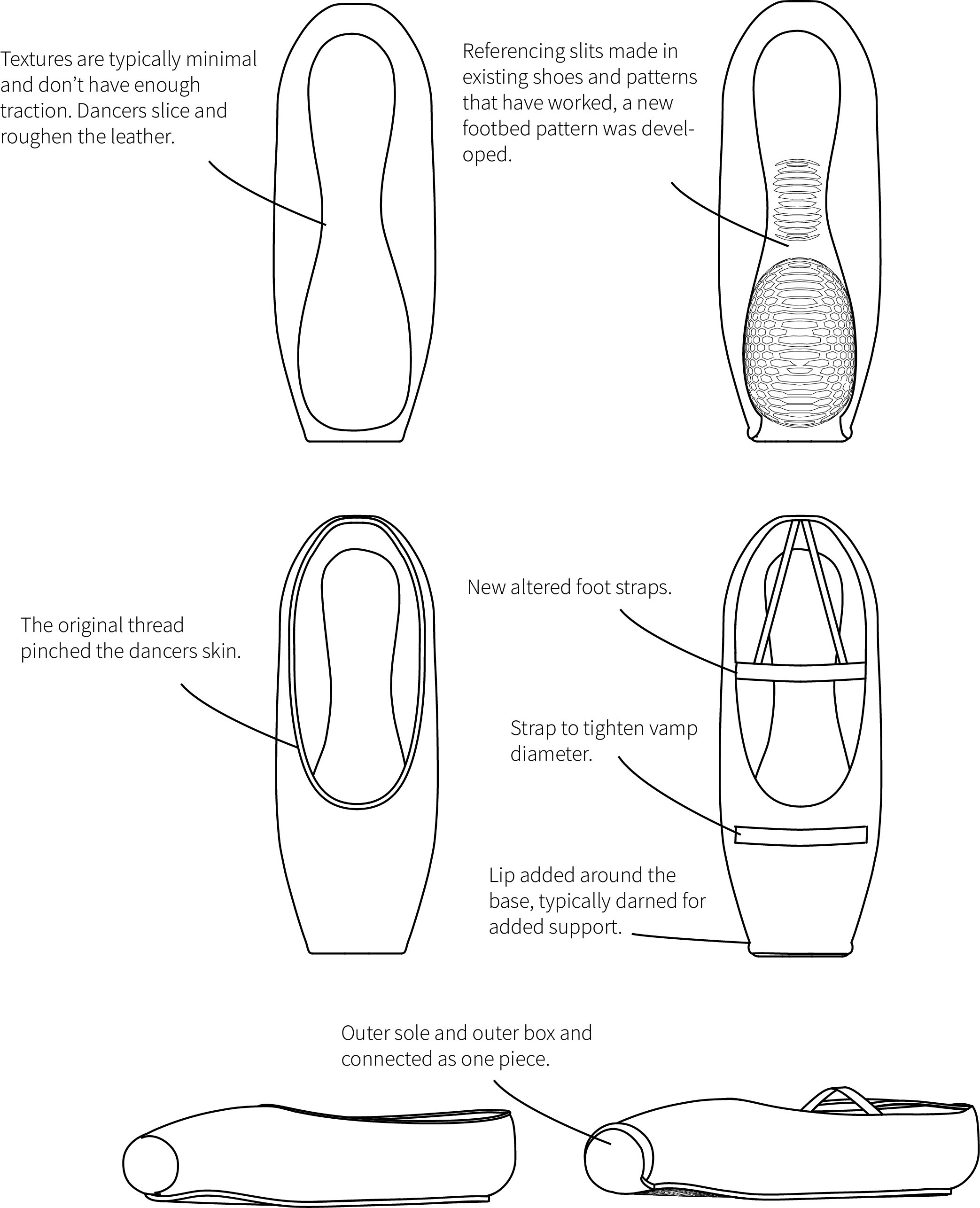[en pointe]
hOW CAN a shoe that has had little development in the past 200 Years be improved?
CONTEXT
A BALLET DANCER’S PAIN POINTS
COST Pointe shoes typically cost around $100. Dancers must pay for their own shoes until they join a company, making training unaffordable for many.
STRUCTURE Dancers usually spend significant time preparing their shoes by breaking them in, sewing elastic, and distressing the platform. This process negatively impacts both the shoe's aesthetics and performance. Shoes last between a single performance to a week in training. To save money, dancer’s replace shoes less frequently, risking their safety.
MATERIAL The satin is typically pink, which doesn't embrace the range of skin tones and isn't breathable.
INITIAL CONCEPT: A clear customizable shoe with a range of interchangeable, replaceable, low-cost parts.
ADAPTABILITY
Interchangeable inserts allow dancers to customize their shoes based on their anatomy, injuries, or flooring conditions.
EQUITY
A highly customizable structure with replaceable parts promotes longevity and cost-effectiveness.
DIVERSITY
The design should revise traditional notions of pink shoes, and reduce the amount of time dancers spend color correcting the shoes to match their skin.
USER RESEARCH - BALLET DANCERS AT FESTIVAL BALLET, PROVIDENCE RI
ALTERATION DOCUMENTATION
Darned lip to stabilize base Scouring to stop slipping Cut insole for flexibility Taped to prevent poking
The bottom satin is often ripped off for traction, and the straps are hand sewn each time.
Super glue reinforcement along the bottom sole to extend the life of the shoe.
After two rounds of meetings, this exploration unveiled even more complexities that initially anticipated, posing significant challenges in created a one size fits all approach as originally intended.
Engaging with users and further delving into breaking down the design construction brought new insights and radical design alterations.
COMPARISONS TO THE TRADITIONAL AND STANDARD NEW DESIGN
ADDITIONAL VARIATIONS THAT COULD BE CHOSEN AT THE TIME OF CONSTRUCTION
OUTER SOLE
Dancers were already cutting the leather and removing the satin bottom for better traction and the satin bottom of the box could be continued into the outer sole as the satin is already usually removed.
BASE LIP
Dancers usually don’t have the time to darn the base of each of their shoes but would always welcome it.
STRAPS
Foot straps were standardized at agreed upon points that secured the ankle so dancers didn’t have to sew theirs each time. Vamp diameters differed by a few millimeters, a vamp strap was added to reduce variables in current market options.
BREATHABILITY
The satin caused the dancers to sweat even more, causing a further deterioration of the shoe. A more structural breathable mesh needs to be explored in future iterations.
INSOLES
Three options deemed most appropriate and generalized based on alterations typically done.
VAMP
The vamp and box variability between brands was only the difference of a few millimeters. Dancers break the vamp, further breaking down it’s durability to achieve flex points for their feet. Depending on the the dancers flexibility, we also generalized three different rigid vamp sizes.
TAKEAWAYS AND FUTURE GOALS
Dancers have become so accustomed to this arduous process and issues that there is little recognition of alternatives. Talking through their issues and mutual struggles and complaints created a productive and collaborative setting that should be continued to best help and illuminate thoughtful redesign.
Maintaining structural integrity while offering interchangeable parts needs to be explored further.
The desired see through qualities of the new shoe impacts the individual components (straps, vamp, etc.) that need to be inserted, additional material and construction need to be further investigated














